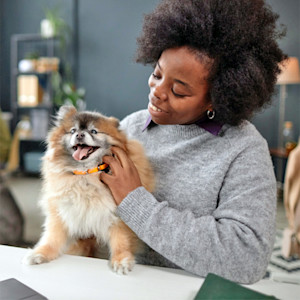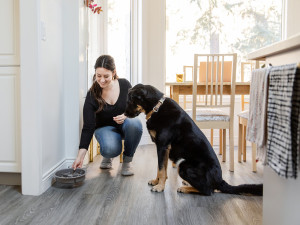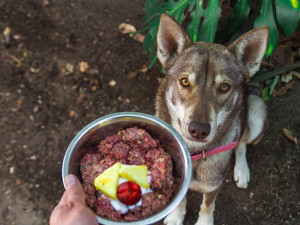Best Food for Dogs With Allergies
Because no one deserves to be uncomfy.

Share Article
In This Article:
Identifying Food Allergies in Dogs Best Food for Dogs with Allergies Managing Dog Allergies Frequently Asked Questions
When your dog suffers from food allergies, finding the right diet can be a challenge. By understanding common allergens, recognizing symptoms, and selecting appropriate food options, you can help your dog maintain a healthy, comfortable life with limited allergy symptoms.
Allergies can be a trigger word for both people and their pets. For those of us who suffer from allergies, we know how miserable they can be, and seeing your pet experience that same discomfort can be heartbreaking. And let’s be real: Trying to treat allergies, avoid allergens, and live with allergy symptoms is not easy, and there is no quick fix for any of it.
It requires patience, consistency, and acceptance to live with allergies and cope with flare-ups. It is crucial to accurately identify food allergies in the first place in order to figure out what foods will work best for your dog and to manage allergies long-term. Read on to learn more about how to help your dog live with food allergies.

Identifying food allergies in dogs
Determining if your dog has a food allergy may sound straightforward, but there are a lot of conditions that can mimic food allergies, and it’s easy to misdiagnose them. For this reason, it’s important to consult your vet right away if you are concerned that your dog has allergy symptoms in order to go about getting a diagnosis in the correct way. This involves:
Identifying food allergy symptoms
Dogs with food allergies most commonly present with itchy skin. This may be especially focused around their ears and also result in recurrent ear infections, along with itchy butts, scooting, and biting and licking their hind end, paws, or bellies. Some dogs will also have digestive issues such as vomiting or diarrhea.
There are many conditions that cause itchy skin, so determining if these signs fit with a food allergy requires a methodical approach. One important point to keep in mind is that if your dog’s signs are caused by a food allergy, they should be consistently showing these signs. Alternatively, if your dog’s symptoms wax and wane with the seasons, they may be more likely to have an environmental allergy or flea allergy.
Consulting with a veterinarian
This should be your first stop in trying to determine what, if anything, your dog is allergic to. Your vet will have a methodical approach to eliminating other possible diagnoses, such as fleas and other skin parasites first. It is very important not to skip these steps, and not to try multiple remedies at the same time, otherwise you won’t know which one actually worked and what the underlying cause for your dog’s discomfort was.
Additionally, there is a standardized approach for testing for food allergies that your vet can guide you through. This testing includes access to prescription foods that are the gold standard for food allergy testing.
Elimination diets
If your dog has been examined by a vet and already treated for other possible causes of itchy skin, an elimination diet is the first step in determining if they have a food allergy. Prior to starting an elimination diet, all other medications, such as steroids, antibiotics, and antihistamines should be discontinued, so you and your vet can see if the diet is truly making a difference in their symptoms.
An elimination diet must be carefully selected to contain a source of protein and carbohydrates that your dog has never been exposed to before. Because beef, dairy, chicken and wheat tend to be more common allergens and also more frequent ingredients in dog food, a food must be selected that is completely free of these ingredients. Often, a novel protein diet is selected that uses a more unique combination like fish, kangaroo, rabbit or duck with potato.
It’s important to let your vet know if your dog has been on a diet previously that contained any of these ingredients or had treats with these ingredients. Prior exposure to the protein and carbohydrate will mean they cannot be used for this purpose.
You’ll also want to be careful to avoid over-the-counter diets for the trial; these diets are typically produced on the same machinery as other diets and may have contaminants from other foods as a result. This means they cannot be used for a strict elimination trial.
Prescription diets used for this purpose are produced with dedicated machinery that will not have any contaminants. Once a diet is selected, it must be fed exclusively for eight weeks to allow adequate time for your dog to respond. During this trial, your dog cannot eat anything other than the diet; this means no treats, no chew toys, and not even flavored medications.
Food challenge
For dogs that respond well to an elimination diet, a food challenge with their original diet is the only way to truly confirm that they have a food allergy. In a food challenge, their former diet is reintroduced for up to two weeks. If their signs like itchy skin or digestive upset recur, this makes a food allergy more definitive. If their signs resolve once they return to their novel diet again, this confirms that they have a food allergy.
Allergy testing
Allergy testing for food allergies is not a recommended way to diagnose a food allergy. Testing that is done on blood samples has a lot of errors and is not considered accurate. Allergy testing directly on skin is also considered an unreliable way to test for food allergies, but is used for testing for other kinds of skin allergies.
Best food for dogs with food allergies
The best foods for dogs with food allergies are going to be specific to avoiding their allergens. This is why a diet trial is so important as it helps to uncover what your dog is allergic to, and will help guide what foods will work for your dog long-term. There are a few different diet choices available for allergic dogs including:
Limited ingredient, novel protein diets
The concept behind these diets is that they minimize the total number of ingredients to reduce how many allergens could potentially be present. The novel protein part is based on the idea that you should feed your dog a protein source they have never been exposed to, so as to ensure it is not what they are allergic to already.
Prescription diets that are designed this way are produced on dedicated machinery in order to prevent cross-contamination with other possible allergens. Pet store and over-the-counter brands are more at risk for contamination, making them poor choices for dogs undergoing a diet trial or with known food allergies.
Hydrolyzed protein formulas
Diets made with hydrolyzed proteins undergo a specialized chemical reaction to break the proteins into such small fragments that they are too small to be recognized by the immune system. This allows them to act as a hypoallergenic diet for dogs that may have a food allergy. This can be a good choice for dogs that have been exposed to many different protein sources in their life, making it difficult to find a novel protein source for them.
Best dog food for dogs with chicken allergies
While chicken can be an allergen for some dogs, it is less common than many people suspect. That said, it is very important to always go through a strict food trial to determine what, if anything, a dog is allergic to. A dog that truly has a chicken allergy will do best on a limited ingredient, novel protein diet or a hydrolyzed protein diet.
It’s important to know that many over-the-counter dog foods have contaminants in them. So, even if a dog food doesn’t contain chicken on the ingredient list, if it is produced on the same machinery as other chicken-based diets or treats, it could still be contaminated with enough allergens to trigger an allergic response in your dog. This is also true of treats and chew toys. If you know your dog has a specific food allergy like chicken, it’s important to stick with safe foods and treats that you know are free of contaminants. Many times, this means purchasing a prescription diet from your vet.
Homemade dog food for allergies
Homemade diets can be an option for dogs with allergies, but it is important to know that cooking a proper balanced diet for your dogopens in new tab tends to be time-consuming and more expensive than purchasing dog food. Also, you will have to abide by the same precautions to avoid contaminants from possible allergens when you are cooking, and this may require purchasing a separate set of bowls and cookware for your dog’s food.
If you plan to use a homemade diet as a long-term diet, it is critical to consult with a veterinary nutritionist to ensure you are providing a complete and balanced diet. This will help you avoid any nutritional deficiencies for your dog that could have serious health consequences.
Managing dog allergies
If you’ve read this far, you have probably come to the realization that there isn’t a simple quick fix for food allergies, and controlling your dog’s symptoms is all about managing their condition.
Consistency and careful planning are the best ways to keep your dog feeling good and to avoid flare-ups. Of course, stuff happens to even the most prepared people, and if your dog gets into some take-out filled with all their allergens, don’t panic. Contact your vet to discuss steps you can take to ease their symptoms during a flare up and get them back on track. Here are some other important management tips:
Strict adherence to the prescribed diet
These diets only work by allowing your dog to completely avoid the allergens that make them itch. If they are eating other foods that contain those allergens, the diet won’t have any effect and their symptoms will persist. If you have multiple pets in the home, you may have to completely separate them during meal times to prevent your dog from sneaking a bite of allergen-laden foods.
Avoiding table scraps and treats
Table scraps and treats have the potential to cause your dog’s allergies to flare up if they contain the allergens at fault, or even if they are contaminated with possible allergens. Your safest bet is to keep these foods away from your dog entirely. If you need treat options for your pup, you can use their own dog food to make treats, or stick with safe fruits and veggies that your vet approves.
Reading labels carefully
If you do want to try a new treat or switch your dog’s diet, you’ll need to scrutinize the labels carefully to look for possible allergens. Even if their specific allergen is not present in the food, you’ll want to be sure these products are made on their own dedicated machinery to avoid contamination. If that’s not clear, proceed with caution.
Gradual transitions to new foods
Any time you change your dog’s diet, it should be a gradual transition to avoid digestive upset. This means that you should mix about 25 percent of the new food into a portion of 75 percent of the food they are used to for the first day or two, and then increase the proportions to 50 percent/50 percent, followed by 75 percent of the new food mixed with 25 percent of the old food. This allows your dog time to adjust to the change.
Change one variable at a time
Any time you want to make an adjustment, be sure to change only one thing at a time so you know what effect, if any, that it had. For example, don’t change their flea, tick, or heart worm medication at the same time you change their food, or introduce a new treat and a new shampoo at the same time.
Multiple changes at once make it impossible to pinpoint what is helping and what isn’t. Try to wait at least two weeks between changes to ensure that you can separate the effects of each one without overlap.
FAQs (People also ask):
What protein are dogs least allergic to?
Every dog will be different but some of the most common food allergies in dogs are to poultry, dairy, beef, and wheat so avoiding those proteins and selecting novel proteins they have never been exposed to, like duck, fish, or rabbit, can be a good starting point.
What food to avoid for a dog with skin allergies?
There is no one food to avoid, but if you suspect your dog has a food allergy that is causing their skin problems, speak with your vet about how to embark on a diet trial. This will involve using a prescription diet with very limited ingredients as your dog’s only food source for at least eight weeks. In general, if you want to select a healthy diet for your dog, there are many other points to consider as well.
Are grain-free diets better for dogs with allergies?
Not necessarily. Dogs may be allergic to many other ingredients, especially proteins, and grain may not have any effect on them one way or another. But there have been cases of dogs developing serious heart disease known as dilated cardiomyopathy as a result of eating certain grain-free diets, so these should be avoided (after you do your research).
References:

Dr. Amy Fox, DVM
Amy Fox, DVM is a small animal veterinarian in New York City with over thirteen years of experience in a mixture of general practice, emergency medicine, and shelter medicine. A lifelong animal lover, Dr. Fox studied biology in college and then worked as a veterinary nurse before pursuing veterinary school at Cornell University. Her expertise includes surgery, dentistry, and management of chronic conditions, and she is interested in toxicology, pain management, nutrition, care of senior pets, and educational outreach. Dr. Fox also enjoys writing about veterinary medicine and teaching, and her work has previously appeared in Spruce Pets. In her free time, she loves to cook, garden, go for long runs, and hang out with her goofy mixed-breed dog May, who provides never ending comic relief!
Related articles
![Young Female Adult Feeds Her Rottweiler mixed breed Dog]()
Wholesome Homemade Dog Food Recipes: Vet-Approved Starter Recipe
All it takes is healthy ingredients and a slow cooker.
![White terrier eating fresh dog food]()
The Scoop on Human-Grade Dog Food
For starters, yes, it’s good enough to eat.
![Dave Coast sitting with a dog]()
Nutritionist Dave Coast Digs Into Grain-Free Dog Food and Heart Disease
The LA wellness guru talks to a holistic veterinarian about the best diet for dogs with allergies and why grain-free food gets a bad rap.
![Woman measuring dog food with scale]()
Should You Put Your Dog on a Low-Calorie Diet?
Diet culture is a tricky thing — for pets, too.
![Husky wolf dog sitting waiting for her natural raw food]()
Everything You Need to Know About the Raw-Food Diet For Dogs
The feeding practice is popular — should you try it?
![Side view of a cute hungry dog standing next to a red bowl with food in a studio with white background]()
How to Get a Dog to Eat
You can’t appease your picky new dog with chicken nuggets like you can with your toddler. Here are some things you can do.










